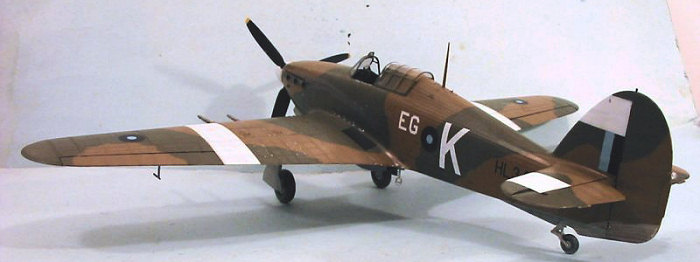
| KIT: | Trumpeter 1/24 Hurricane IIc |
| KIT #: | 02416 |
| PRICE: | $149.95 MSRP |
| DECALS: | Two options |
| REVIEWER: | Tom Cleaver |
| NOTES: |

| HISTORY |
Eclipsed by publicity during the Battle of Britain by its more graceful-looking stablemate, the Spitfire, the Hawker Hurricane has always lived in the elliptical-winged shadow of Reginald Mitchell's revolutionary masterpiece. Rather than a stroke of genius, the Hurricane was evolutionary in its heritage, standing as it did atop the body of work of its designer, Sir Sidney Camm, who had and would design many of the most famous and successful aircraft used by the Royal Air Force for ten years previous and another thirty years after the Hurricane's appearance.
In an effort to improve the performance of the Hurricane, Hawker proposed the introduction of the Mark II, which would be fitted with the Merlin XX, offering 1,260 h.p. and a two-speed supercharger. A Hurricane I flew with this engine in June 1940 and demonstrated an increase in top speed from 315 m.p.h. to 348 m.p.h., while also improving the useful combat altitude to more than 20,000 feet. The first Hurricane IIs equipped 111 Squadron of Fighter Command by October 1940. A program for an increase in armament had seen a Hurricane I equipped with two 20mm cannon slung below the wings, which flew May 24, 1939. The Hurricane IIC carried 4 20mm cannon internally, and was equipped to carry two 250-lb or 500-lb bombs in the fighter-bomber role. The first Hurricane IIC’s arrived in squadrons of Fighter Command in late April 1941.
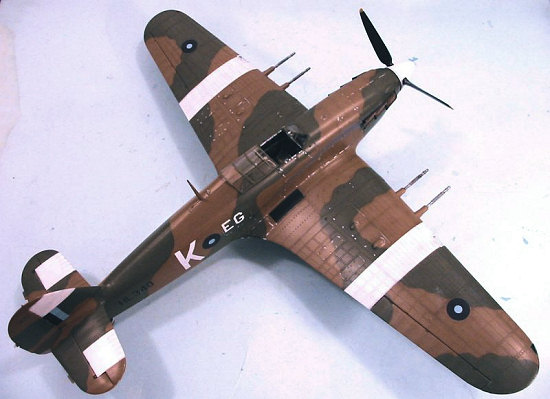 Hurricane IIs were first sent to the Middle East in the fall of 1941 and served
in the fighter bomber role in the Mediterranean until the end of the war.
During the War, the Hurricane served in more theaters of operation than any
other aircraft, from England to the jungles of Malaya and Burma, from arctic
Archangel in the U.S.S.R. to the Suez Canal and the Western Desert. In fact,
the Hurricane is one of the very few aircraft of the Second World War to have
flown in air forces on both sides, if one considers its service in the Finnish
and Romanian Air Forces.
Hurricane IIs were first sent to the Middle East in the fall of 1941 and served
in the fighter bomber role in the Mediterranean until the end of the war.
During the War, the Hurricane served in more theaters of operation than any
other aircraft, from England to the jungles of Malaya and Burma, from arctic
Archangel in the U.S.S.R. to the Suez Canal and the Western Desert. In fact,
the Hurricane is one of the very few aircraft of the Second World War to have
flown in air forces on both sides, if one considers its service in the Finnish
and Romanian Air Forces.
The first Hurricane IIs to reach the Far East arrived in Singapore in late January 1942, following the Japanese attack on December 8. Following the Japanese conquest of Malaya and Burma, Hurricanes were quickly sent to India, where they became the first-line RAF fighter equipment until Spitfire VIIIs began to arrive in 1944, and continued to serve as fighter-bombers with the RAF until replaced by the Thunderbolt II in late 1944.
After the RAF and the Soviet Union, the largest user of Hurricanes was the Royal Indian Air Force. following the dispatch of Hurricane Is from the Middle East for training purposes in the Spring of 1942, enough Hurricane IIBs were transferred to the RIAF in 1943 to equip No. 1 Squadron. In 1944, over 200 Hurricane IICs were transferred to equip seven RIAF squadrons in time for their participation in opposing the last Japanese offensive of the war; the fighting on the Second Arakan and Imphal campaigns commencing in the summer of 1944. RIAF squadrons, flying as both fighters and fighter-bombers acquitted themselves well in direct air support of the Indian Army in numerous difficult situations, as well as against what was left of the JAAF in the theatre.
Despite its seeming obsolescence, the Hurricane remained in first-line service throughout the Second World War, one of only seven aircraft in service with any air force on September 3, 1939 to achieve that status.
| THE KIT |
Trumpeter’s big Hurricane first appeared in May, with the release of the Hurricane I. This Hurricane IIc differs from that kit in that the fuselage has been modified to the Hurricane II standard with the lengthened nose, and with changes to the wings for the four-cannon armament, with different gun bay covers, a different wing leading edge, and the lower wing modified with the cannon ejection ports.
The
Hurricane I kit lacked the circular core for the radiator, which I commented on
unfavorably at the time. It turns out that is correct for the Hurricane I.
This kit has the circular core, which is right for the Hurricane II. The kit
also has the different spinner, 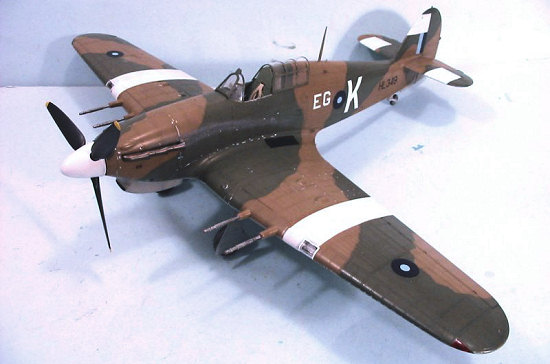 and the propeller blades - which were wrong for
the Mark I are correct for the Mark II. The kit does not include bomb racks or
bombs; these will be included in a future release this coming October.
and the propeller blades - which were wrong for
the Mark I are correct for the Mark II. The kit does not include bomb racks or
bombs; these will be included in a future release this coming October.
These Trumpeter kits might be the best Hurricane kits released to date. The fabric surface detail of the ailerons, vertical fin and rudder, and the horizontal stabilizer and elevators, is very nicely restrained, while the fabric detail on the rear fuselage looks very close to what I see when I look at the 1:1 Hurricane out at Planes of Fame. Yes, there are engraved rivets, but they are very restrained, like the SBD Dauntless and the Me-262 kits, and the surface looks “accurate” to me in the same way the SBD kit’s surface detail does when compared to the real thing once it’s been painted.
The cockpit is nicely detailed, and a photoetched seatbelt harness is provided - a good thing since there are no 1/24 aftermarket seatbelts I am aware of. This is the only Hurricane kit that gets the area of the cockpit underneath the canopy at the immediate rear correct.
The Merlin engine provides a good basis for anyone who wants to super-detail the engine. The lower side panels are provided in clear plastic for those who want to display the engine.
The decals suck, but that’s a given with Trumpeter. The red and blue is much too bright. The kit includes markings for one of the “MacRobert Fighters,” which were presented by Lady MacRobert in memory of her four sons who were all lost in service with the RAF and flown by 294 Squadron, and another flown by 213 Squadron. Both of these are in the desert camouflage of Dark Earth and Mid Stone upper surfaces and Azure Blue lower surfaces. Unfortunately, there are no alternative decals with the later insignia in 1/24 scale.
| CONSTRUCTION |
While the kit is large and daunting-looking in the box, it is really no more
difficult than the 1/48 Hasegawa Hurricane to construct. As is usual with
Trumpeter, there are a lot of parts that make me wonder why they are there, and
- like the Hurricane I - these parts never made it off the sprues. The gun bays
and cannons would look good if they were super-detailed in this scale. The
engine is unchanged from the Merlin II engine that was provided in the first
kit, and would have to be modified to a Merlin XX if it was to be displayed with
the cowling open. Any modeler who wanted to do all this would be rewarded
with a great-looking model, but a great deal of
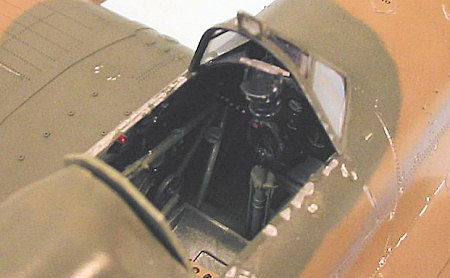 work would be required.
work would be required.
Myself, I was interested in building a basic model, so other than the engine - which was needed as a base on which to mount the exhausts and the prop - I left out all the detailed parts one wouldn’t see.
The gun bay doors for this kit fitted much better than those of the Mark I, and were attached before the wing was assembled.
As I found with the first kit, there was no difficulty in assembling the model, other than to find a space large enough to set it at the conclusion of each session. The cockpit is about as detailed as the Hasegawa kit - in part this is due to the fact that the Hurricane has a very simple cockpit. I decided that I would use the kit-supplied photo-etch harness, instead of the Eduard 1/32 RAF Early Style harness I used on the first model, to see what the result was. This seatbelt set is acceptable if one doesn’t have an aftermarket alternative, but took a lot of work to pose in a realistic position. I still think that the 1/32 seatbelts are just enough oversized in 1/32 scale that they look far more accurate than the kit-supplied set. I also drilled out the instrument faces in the clear instrument panel, since painting around the clear glass was too much trouble in my experience of having tried this with the instrument panel on the Trumpeter 1/24 Fw-190D-9.
While the kit has separate control surfaces, I decided to leave the controls in the neutral position because the elevators do not look entirely right when drooped.
| COLORS & MARKINGS |
Painting:
Having rediscovered a Model Decal sheet of SEAC markings that could be used for
this kit, I decided to do this as a SEAC Hurricane in the Temperate Land
Scheme. After pre-shading the model with flat black airbrushed over the panel
lines, I painted 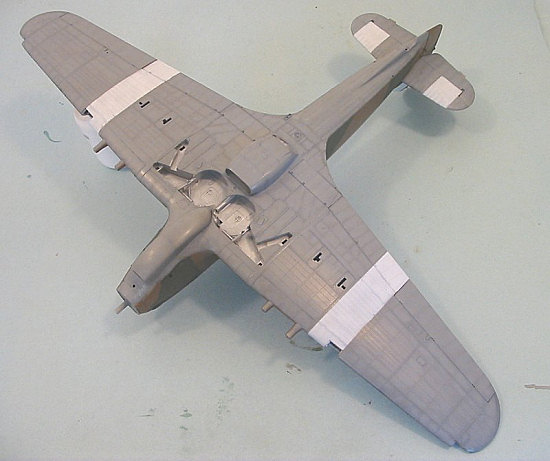 the areas of the ID stripes with Tamiya Flat White, then masked
them off. The camouflage was done with Xtracrylix Dark Earth, RAF Dark Green
and Sea Grey Medium. I “sun faded” the upper surfaces by first adding in some
lighter colors to the upper camouflage colors, then adding in white and going
back over the surfaces most exposed to the sun, then thinning the paint with 70
percent thinner and adding in more white, which I applied over the area to give
“depth” to the paint and give it a thorough sun-faded appearance. I added RAF
Interior Green to the Dark Green to lighten it, while adding in Gulf War Armor
Tan to the Dark Earth. This was the same system I described in detail to give a
sun-faded appearance to the Trumpeter SBD-2 kit last year.
the areas of the ID stripes with Tamiya Flat White, then masked
them off. The camouflage was done with Xtracrylix Dark Earth, RAF Dark Green
and Sea Grey Medium. I “sun faded” the upper surfaces by first adding in some
lighter colors to the upper camouflage colors, then adding in white and going
back over the surfaces most exposed to the sun, then thinning the paint with 70
percent thinner and adding in more white, which I applied over the area to give
“depth” to the paint and give it a thorough sun-faded appearance. I added RAF
Interior Green to the Dark Green to lighten it, while adding in Gulf War Armor
Tan to the Dark Earth. This was the same system I described in detail to give a
sun-faded appearance to the Trumpeter SBD-2 kit last year.
The wheel wells, landing gear and interior of the gear doors were painted with Talon acrylic Aluminum.
When everything was dry, I unmasked the white stripes and gave the model a coat of Xtracrylix Gloss Varnish.
Decals:
I used the Model Decal national insignia, and found ID letters that would allow me to do a 34 Squadron Hurricane in the decal dungeon. I used the 1/48 underwing serials from an Xtradecals Meteor 8 sheet to do the serial number (since 24 inches in 1/48 translates to 12 inches in 1/24). I used the kit decal sheet for the stencils and the individual aircraft letter.
| FINAL CONSTRUCTION |
I gave the model several coats of Xtracrylix Flat Varnish to get the surface as flat as possible. I “dinged” the various cowling panels and leading edges of the wings with Model Master Aluminum lacquer. I applied a heavy exhaust stain, adding in a bit of grey to Tamiya “Smoke” and keeping it well-thinned to simulate an engine tuned to provide range. The cannon barrels were painted with Talon acrylic Gunmetal and attached. I assembled the landing gear and attached it in position and finished off by attaching the clear covers over the navigation lights.
| CONCLUSIONS |
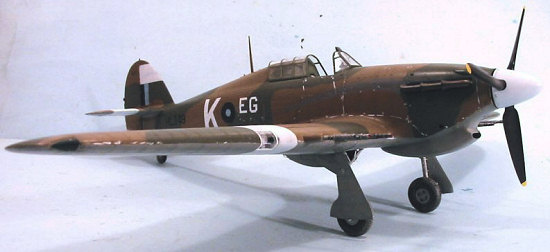 Most
modelers who do a Trumpeter 1/24 Hurricane are going to opt to do only one since
it’s a really big model and creates storage space problems. I think that this
Mark IIC kit is overall more accurate as a model than the Mark I, with superior
fit for the separate detail pieces for the wing and the tropical filter, but
both kits make up into impressive models. I wish we would see aftermarket
decals for this kit, since there are some very interesting squadron markings,
and there is a crying need for more accurate national insignias as regards
correct colors; however, I wonder if the kit will sell in sufficient numbers to
attract the aftermarket companies.
Most
modelers who do a Trumpeter 1/24 Hurricane are going to opt to do only one since
it’s a really big model and creates storage space problems. I think that this
Mark IIC kit is overall more accurate as a model than the Mark I, with superior
fit for the separate detail pieces for the wing and the tropical filter, but
both kits make up into impressive models. I wish we would see aftermarket
decals for this kit, since there are some very interesting squadron markings,
and there is a crying need for more accurate national insignias as regards
correct colors; however, I wonder if the kit will sell in sufficient numbers to
attract the aftermarket companies.
If you like the Hurricane and want to create a project that can take all the additional detail work you care to lavish on it, or just want a big impressive model of a favorite airplane out of the box, this Trumpeter kit will fill the bill.
Review kit courtesy of Stevens International.
June 2007
If you would like your product reviewed fairly and quickly by a site that has over 350,000 visitors a month, please contact me or see other details in the Note to Contributors.